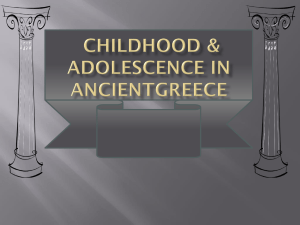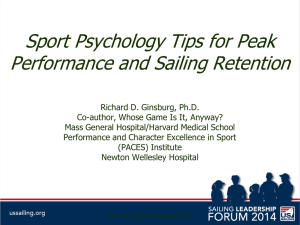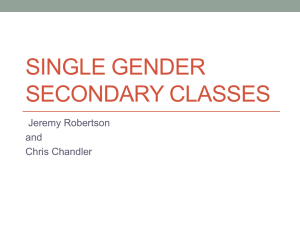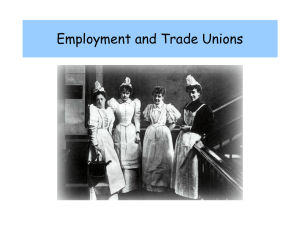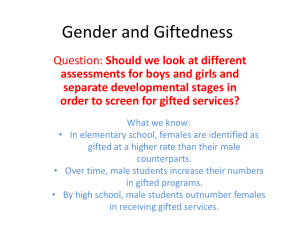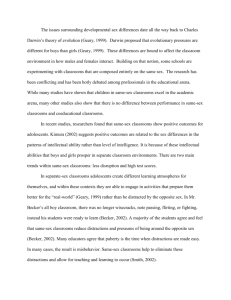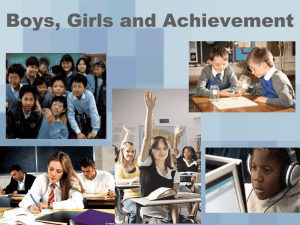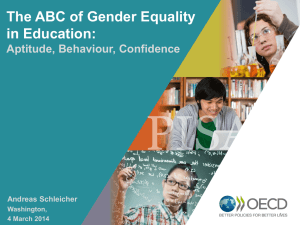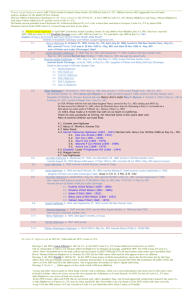Action Research Midterm
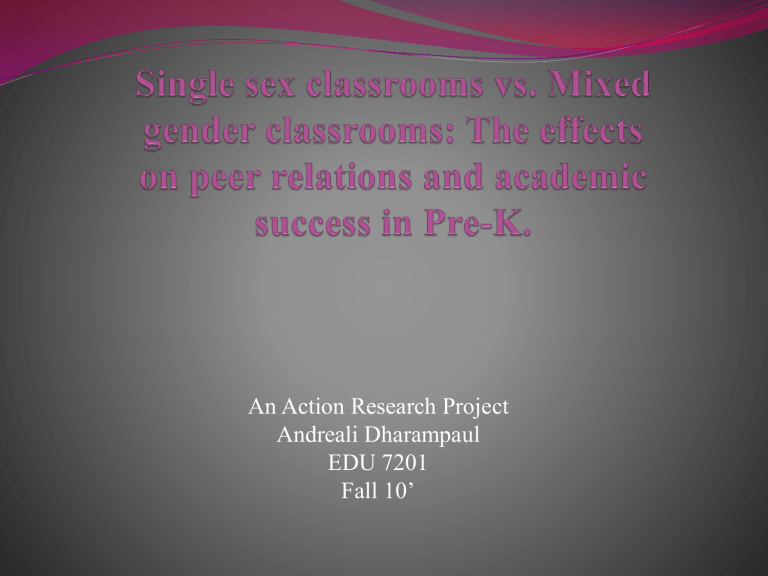
An Action Research Project
Andreali Dharampaul
EDU 7201
Fall 10’
Table of Contents
Introduction
- Statement of the problem
- Review of related literature
*Pros
*Cons
* Practitioners
- Statement of the Hypothesis
References
Statement of the Problem
In early childhood, students tend to interact with same sex peers when in a mixed gender classroom, where as in the upper grades students tend to interact with both genders. A lot of research has been done to show the positive and negative influence same sex classrooms have over mixed gendered classrooms in childhood education. Many researchers have concluded that sex composition plays a role in the outcome of a student’s academic success and peer relations in the classroom. Although there is research that concludes the effect sex composition has on a childhood student’s academic success and peer relations, not much research has been done in early childhood education to support this theory. Is a student’s academic success and peer relation influenced by their classroom sex composition in early childhood or is it irrelevant during these early stages in their education?
Review of Related Literature
To ensure the success of single sex schooling :
Single sex schooling must have an important objective
Student enrollment must be made voluntary in such classroom setting.
(Jorgensen & Pfeiler, 2008; Okopny, 2008).
Review of Related Literature
Pros: Academic Success
Female students profit less than male students in cooperative learning when in a mixed gendered science classroom.
(Ding, Harskamp & Suhre, 2008).
Students enrolled in a same sex science classroom demonstrated more positive science achievement.
(Friend, 2006).
Same sex classrooms have a positive outcome for both boys and girls academic success, increased student commitment and fewer sexually stereotyped behaviors.
(Forbes- Jones, Friedman, Hightower & Moller, 2008; Cohen & Barton, 2004;
Jorgensen & Pfeiler, 2008, Hutton, Kilpatrick & Wills, 2006).
Review of Related Literature
Pros: Academic Success
Boys struggle academically because boys and girls are biologically and developmentally different.
( Okopny, 2008; Hutton, Kilpatrick & Wills, 2006; Kommer, 2006, Laster,
2004, Whitehead, 2006).
Review of Related Literature
Cons: Peer Relations
Sex accounts for less than 2% to 5% in most studies that focus on behavior, spatial, language and/ or mathematical abilities. In contrast for choice of play partners sex accounts for 70% to 80% in early childhood.
(Palmer, 2004).
Children between the ages of three and five show evidence of stereotypical gender cues & such segregation may lead to limited opportunities in their education and careers in the future.
(Palmer, 2004; Okopny, 2008; Medina, 2009; Hutton, Kilpatrick & Wills. 2006).
Boys form larger mutual friendships where as girls experience a negative change in social behaviors.
(Cohen & Barton, 2004; Forbes- Jones, Friedman, Hightower & Moller, 2008).
Review of Related Literature
Cons: Peer relations
Girls show greater academic competence when less time was spent with the same sex, and boys showed less academic competence when more time was spent with same sex peers in preschool.
(Fabes, Martin, Hanish, Anders & Madden- Derdich, 2003, Laster, 2004).
Girls seek close proximity behaviors when boys are the majority.
(Fabes, Martin, Hanish, Anders & Madden- Derdich, 2003; Cohen & Barton,
2004; Forbes- Jones, Friedman, Hightower & Moller, 2008).
-
Theorist
Bem’s Gender Schema Theory:
Gender schematic processing is a result of people’s gender typing. They tend to process information, including information about themselves according to the culture’s definitions of masculinity and femininity.
(Katsurada & Sugihara, 2002)
Spence’s muti-factorial model of gender identity:
Gender related personality, attitudes, and behaviors are relatively independent. “At the level of the individual these different kinds of genderrelated attributes, attitudes, and behaviors do not necessarily have common developmental histories
”
(Katsurada & Sugihara, 2002)
Statement of the Hypothesis
HR:
- During a one week instruction, Andreali Dharampaul will implement theme related activities to her mixed gender pre-k classroom in an urban private school located in East Flatbush as a single sex classroom. Observing her students during instruction she will record any changes in her students peer relations and academic accomplishments and compare her observations to a one week instruction in her normal mixed gender classroom composition using the same theme.
References
Anders, M. C., Fabes, R. A., Hanish, L. D., Madden-Derdich, D. A., & Martin, C. L. (2003). Early school competence : the roles of sex-segregated play and effortful control. Developmental Psychology, 39 (5),
848-858.
Cohen, R., & Barton, B. K. (2004). Classroom gender composition and children’s peer relations. Child Study Journal, 34 (1), 29-45.
Ding, N., Harskamp, E., & Suhre, C. (2008). Group composition and its effect on female and male problem-solving in science education. Educational Research, 50 (4), 307-318.
Fabes, R. A., Hanish, L. D., & Martin, C. L. (2004). The next 50 years: considering gender as a context for understanding young children’s peer relationships.
Merrill-Palmer Quarterly, 50 (3), 260-273.
Friedman, R., Hightower, D. A, Jones, F. E., & Moller, A. C. (2008). The developmental influence of sex composition in preschool classrooms: boys fare worse in preschool classrooms with more boys.
Early Childhood Quarterly , 23 (3), 409-418.
Friend, J. (2006). Research on same-gender grouping in eighth grade science classrooms. Research in Middle
Level Education Online, 30 (4), 1-15.
Hutton, B., Kilpatrick, S., & Wills, R. (2006). Single-sex classes in co-educational schools.
British Journal of Sociology of Education, 27 (3), 277-291.
References
Jorgensen, N. S., & Pfeiler, C. (2008). Successful single-sex offerings in the choral department.
Music Educators Journal, 95( 5), 36-40.
Katsurada, E. & Sugihara, Y. (2002). Gender- role identity, attitudes toward marriage, and gendersegregated school backgrounds. Sex Roles, 47 (5/6), 249-258.
Kommer, D. (2006, July/August). Boys and girls together: a case for creating gender-friendly middle school classrooms. The Clearing House , 247-251 .
Laster, C. (2004, September). Why we must try same sex instruction. Education Digest, 59-62.
Medina, J. (2009, March 11). Boys and girls together, taught separately in public school. The New York
Times. Retrieved from http://www.nytimes.com
Okopny, C. (2008). Why jimmy isn’t failing: the myth of the boy crisis. Feminist Teacher, 18 (3), 216-228.
Whitehead, J. M. (2006). Starting school- why girls are already ahead of boys. Teacher Development,
10 (2), 249-270.
NASSPE
-
-
-
“ Non- profit organization founded in 2002, dedicated to the advancement of single-sex public education for both boys and girls”
Provide workshops
Share latest research
Provide information http://www.singlesexschools.org/home-nasspe.htm


